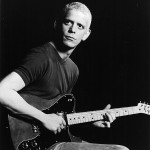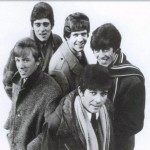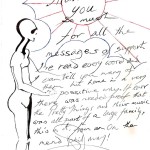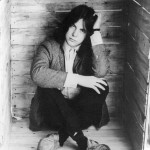-
Featured News
Patti Smith Upcoming Tour for 50th Anniversary of Horses
 By Harvey Kubernik
“Horses was like the first cannon blast in a war – frightening and disorienting. I mean, she was so unlike the FM radio terrain in every way. She was literate, aggress
By Harvey Kubernik
“Horses was like the first cannon blast in a war – frightening and disorienting. I mean, she was so unlike the FM radio terrain in every way. She was literate, aggress -
Featured Articles
Chasing the White Light: Lou Reed, the Telepathic Secretary and Metal Machine Music
 By David Holzer
Fifty years ago, Lou Reed released Transformer. In among “Walk on the Wild Side,” “Make Up” and “Vicious,” cuts that would launch a cartoon Rock N Roll Animal pers
By David Holzer
Fifty years ago, Lou Reed released Transformer. In among “Walk on the Wild Side,” “Make Up” and “Vicious,” cuts that would launch a cartoon Rock N Roll Animal pers -
Trevor ‘Dozy’ Davies: Obituary by Alan Clayson

As the Beatles are to Liverpool, so Dave Dee, Dozy, Beaky, Mick & Tich are to Salisbury. Indeed, the Wiltshire county town displayed its pride in the group via the placing of an honorific blue plaque on the wall of the City Hall on the 40th anniversary of their “Legend Of Xanadu” topping the British charts in 1968. The previous year, the group had occupied five concurrent positions in West Germany’s Top 20, and had beaten the Beatles by over three thousand readers’ votes in a poll organized by the federal republic’s principal pop journal Bravo—which also published a major news item detailing 24-year-old Dozy’s wedding in November 1968.
‘Dozy’ was Trevor Davies, who attended the primary school in Enford, then a Wiltshire farming community, prior to studying at Durrington Secondary Modern—and a road-to-Damascus moment when Buddy Holly and the Crickets appeared in Salisbury in 1958. “I was young and impressionable,” admitted Davies, “but Buddy astounded me just by his very stage presence.”
Acquiring an acoustic and then an electric bass guitar, Davies joined the Beatnicks, where he found himself alongside Ian ‘Tich’ Amey. By 1961, however, the two had been incorporated into Ronnie Blonde & the Bostons with John ‘Beaky’ Dymond, David ‘Dave Dee’ Harman and drummer Stan Poole. After the departure of vocalist Blonde in 1962, Dave Dee became nominal leader when they undertook first professional bookings, zig-zagging across Scotland at a time when Britain’s only motorway terminated at Birmingham, and such an odyssey was truly hellish. Then came arduous seasons in Cologne and Hamburg clubland which led to the replacement of Poole with Mick Wilson, a friend of Davies.
Now a hard act to follow, Dave Dee & the Bostons acquired a shrewd management and songwriting team in Ken Howard and Alan Blaikley which, combined with a change of name, led to a maiden Top 30 strike with “You Make It Move,” and its “Hold Tight!” follow-up coming with an ace of Number One. So began a four year run of world-wide hits that embraced artistic progress that went beyond orthodox beat group instrumentation—as illustrated by the use of balalaika on “Okay!,” and a South American charrasga on “Zabadak!” (which lent its name to a present-day DDDBMT fan club magazine). Moreover, the quintet’s parameters as composers of B-sides and LP tracks were proficient, even adventurous—as instanced by 1967′s psychedelic “The Sun Goes Down’ “co-written by Davies, with its an abrupt concluding tape-edit that anticipated that in the Beatles’ “I Want You (She’s So Heavy)” on Abbey Road. In retrospect, the chasm between the ‘rock’ of the more intellectually revered Beatles, and the ‘vulgar’ pop of DDDBMT is far from unbreachable. In parenthesis, Davies proved an assured lead vocalist when required—as instanced by “Hands Off” on the second album.

Dave Dee, Dozy, Beaky, Mick & Tich. Trevor ‘Dozy’ Davies 2nd from right.
By 1969, however, DDDBMT and their mentors were running out of ideas, and the group split in two. Dave Dee went solo while Dozy, Beaky, Mick and Tich (as ‘DBMT’) attempted to rise anew with a prog-rock repertoire, as instanced by a mild cause célèbre of an album, 1970′s Fresh Ear Me). One associated single, “Tonight Today,” penetrated the Top Ten in the Netherlands.
Inevitably perhaps, both factions of the old firm resumed an intermittent recording career together in 1974 with “She’s A Lady.” All members continued, nevertheless, however, to pursue extra-mural projects, as Davies, Amey and Dymond did in Tracker. Yet despite a well-received tour of Germany, this promising trio sundered in 1975. Davies also functioned as one of Woodsmoke, a country & western duo, and recorded songs penned solely by himself for submission to other artists. Then DBMT reunited in the late 1970s, most conspicuously with “In the Coven,” a single that might have been a surefire smash had it been attributed to Dave Dee, Dozy, Beaky, Mick & Tich during their “Zabadak!”-“Xanadu” commercial prime.
It was not heard on stage, however, when DDDBMT began focusing chiefly on the Sounds Of The Sixties nostalgia circuit (with a set that sometimes included a showstopping Johnny Cash impersonation by Davies) while tilting occasionally at the charts with such as 1983′s disco-tinged “Staying With It,” a revival of Manfred Mann’s “Do Wah Diddy Diddy,” and grafting a Status Quo-esque blues-boogie rhythm onto “Here We Go,” the soccer match ditty that lives in its Offenbach melody.
Though Dee died in 2009, Dozy, Beaky, Mick and Tich were still performing together sith the enthusiasm of their younger selves until Davies was diagnosed with acute pancreatic cancer a week before his own death.
He is survived by his wife Yvonne, children Darren and Sarah, and five grandchildren.
‘Dozy’ (Trevor Leonard Ward-Davies), born 27 November 1944, died 13 January 2015
A thank you from Phil May to his fans

Phil has now been out of the hospital for some time, and is making good progress with his health. He has been very touched by the deluge of letters and cards he’s received so far from Pretty Things fans. Please keep them coming.
Letters to PHIL MAY

As you probably already know, Phil May is currently in the hospital after suffering breathing difficulties. He has been diagnosed with COPD, a serious disease affecting the lungs. Phil can beat this, but he needs your help and encouragement. He needs to give up drinking and especially smoking urgently and immediately. Those closest to him believe the best chance he has of doing this is to turn his lifestyle around, and immerse himself again in art, music and writing.
How can you help? Write a personal letter to Phil today. Give him your encouragement. It’s important that he knows that what he does artistically has value and connects with you. Tell him how much his music has meant to you. Explain why you are a fan of the Pretty Things. Write about why a particular Pretty Things song, album or live show has meaning for you. Share your own story of kicking drink, drugs or smoking or of overcoming a potentially deadly illness or disease. Let him know that what he does matters. We feel if Phil returns home to a flood of letters like this, he’ll be inspired to make the changes he needs to make,
What to do: Write your letter today, and mail it to the address below.
Phil May
c/o Ugly Things
PO Box 3021
La Mesa, CA 91944
USA
All letters will be forwarded unopened to Phil’s home in London. We need LETTERS. Emails or Facebook comments won’t get the job done. Phil is not a computer person; he won’t ever see them. Only a letter has the personal touch that will get our message through. Write today, do not delay. This is your chance to make a difference and help save Phil.